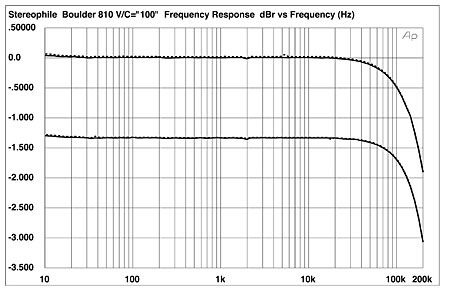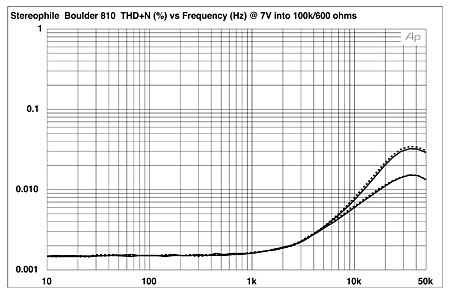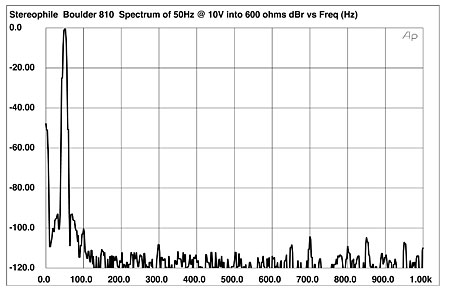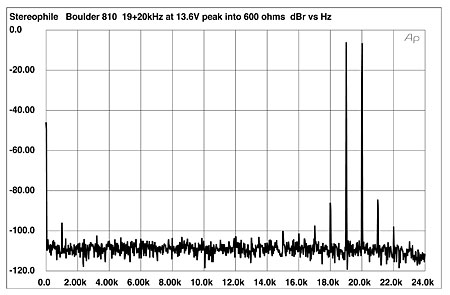| Columns Retired Columns & Blogs |
Boulder 810 line preamplifier & 860 power amplifier 810 Measurements
Sidebar 4: 810 Measurements
The Boulder 810 preamplifier turned out to be immune to grounding problems between my Audio Precision test set, always a sign of competent engineering. (With well-engineered products, I end up tearing out much less of my hair in trying to find which combination of signal generator and analyzer and amplifier signal and chassis ground connections minimizes hum loops. Sometimes it's "none of the above.") With the volume at its maximum setting of "100," the 810's voltage gain was exactly to specification, at 20dB. Accordingly, the unity-gain setting of the volume control was "–20." The preamplifier preserved absolute polarity for both balanced and unbalanced inputs—ie, was non-inverting—with pin 2 of the input and output XLR jacks wired as hot.
The input impedance was a high 86k ohms at low and middle frequencies, dropping inconsequentially at 20kHz to 74k ohms. The balanced output impedance was a usefully low 100 ohms at all frequencies; running the preamp unbalanced results in an impedance exactly half this figure. The 810's frequency response with the volume control set to "100" is shown in fig.1, into 100k ohms (top) and 600 ohms (bottom). The output is flat within the audioband, down 1.8dB into both loads, and doesn't change with the volume-control setting. The 810's channel separation (not shown) was simply superb, at better than 125dB below 1kHz and still a very high 110dB at 20kHz. The worst-case signal/noise ratio (ref. 1V output with the input shorted but the volume control at its maximum) was also excellent, at 90dB A-weighted, worsening to 75dB with a wideband, unweighted measurement.

Fig.1 Boulder 810, frequency response at 1V into (from top to bottom at 2kHz): 100k, 600 ohms (0.5dB/vertical div., right channel dashed).
Fig.2 shows how the THD+noise percentage in the 810's output changes with output voltage, into 100k ohms (bottom trace) and 600 ohms (top). The maximum output voltage was a high 18V into 100k ohms and 15V into 600 ohms. The downward slope of the traces below 7V or so is due to the distortion lying under the noise floor below this level. Accordingly, I plotted the THD+N percentage against frequency at 7V to be sure of revealing the actual distortion (fig.3). Even so, the THD rises above its vanishingly low level only in the top audio octaves, and even then, to maxima of only 0.015% at 35kHz into 100k ohms and twice that into 600 ohms.

Fig.2 Boulder 810, THD+noise (%) vs output voltage into (from bottom to top at 1V): 100k, 600 ohms.

Fig.3 Boulder 810, THD+N (%) vs frequency at 7V into (from bottom to top at 10kHz): 100k, 600 ohms (right channel dashed).
That this is a very linear preamplifier is confirmed by the spectrum of its output driving a 50Hz tone at 10V into 600 ohms (fig.4). The only harmonic visible is the second, at –100dB (0.001%; the higher-order spuriae in this graph are, I believe, mathematical artifacts and not representative of the preamp's behavior). At a 1V output level into 100k ohms, both figures more typical of actual use, the distortion was just 0.0005% (true sum of the harmonics). Again, the second harmonic was the highest in level, at –108dB (not shown), with the third and fourth harmonics at –112dB, which is only 8dB higher than the residual THD of my test gear. Intermodulation distortion, even at 13.6V peak into 600 ohms, which was just below visible clipping on the oscilloscope, was very low (fig.5).—John Atkinson

Fig.4 Boulder 810, spectrum of 50Hz sinewave, DC–1kHz, at 10V into 600 ohms (linear frequency scale).

Fig.5 Boulder 810, HF intermodulation spectrum, DC–24kHz, 19+20kHz at 13.6V peak into 600 ohms (linear frequency scale).
- Log in or register to post comments




































